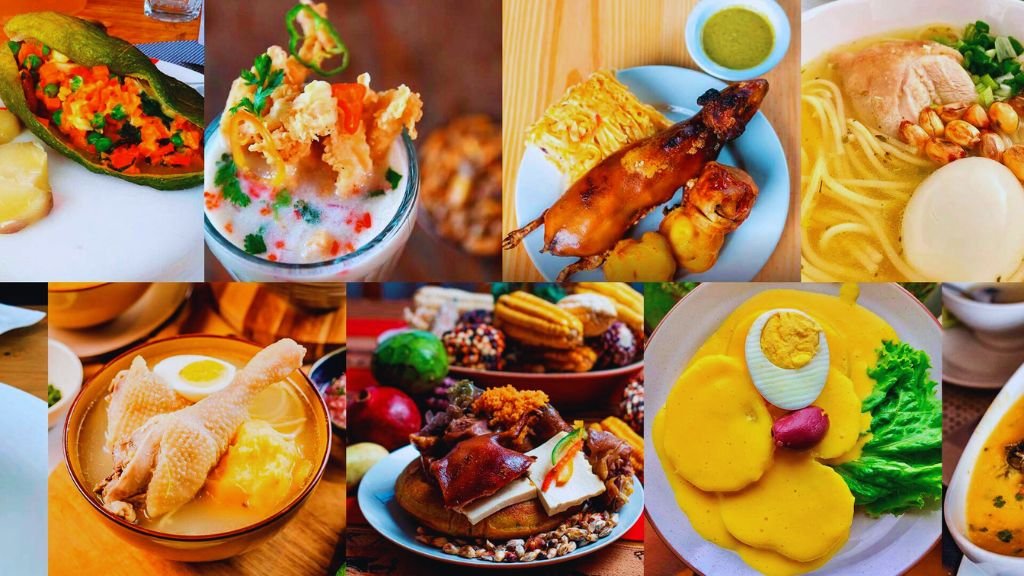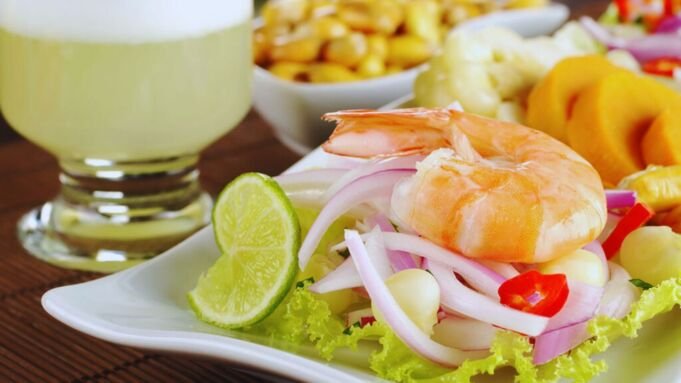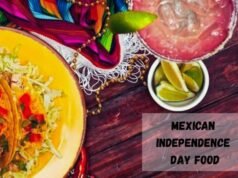Peruvian food stands as a vivid portrayal of its diverse culture, landscape, and historical tapestry. Renowned for its diversity and richness, Peruvian food is a colorful tapestry woven from the country’s varied geography, extensive history, and multicultural influences. From the high peaks of the Andes to the depths of the Amazon rainforest and along the sprawling Pacific coast, each region brings its unique ingredients and recipes to the table.
In this exploration of Peruvian culinary delights, we’ll discover how ancient traditions blend seamlessly with immigrant influences to create dishes that are not only mouthwatering but also a profound reflection of Peru’s cultural heritage.
Get ready to taste the true essence of Peru through its most beloved dishes, from the world-famous ceviche to the hearty and comforting aji de gallina. Join us on this delicious journey and find out why Peruvian cuisine continues to be one of the most fascinating and celebrated cuisines around the world.
What does Peruvian Taste Like?
Peruvian cuisine is a symphony of bold flavors and vibrant colors, characterized by its diverse palate that seamlessly blends sweet, sour, spicy, and savory elements. At the heart of the taste experience are native ingredients like ají peppers, which lend a gentle heat and a distinctive brightness to dishes.
Citrus, particularly lime, adds a zesty punch that complements the freshness of ingredients like seafood in ceviche, where raw fish is cured in lime juice and spiced with chili peppers. Herbs such as cilantro and huacatay (Peruvian black mint) contribute verdant, aromatic nuances. Peruvian dishes often feature a balance of earthy and robust flavors from ingredients like potatoes and corn, with a creamy richness introduced through sauces based on cheese and nuts.
The influence of historical migrations is also palpable, with hints of sweetness from Asian influences and savory depths from Spanish and African culinary traditions. Overall, Peruvian cuisine offers a delectable, complex, and harmonious blend of flavors that reflect its rich cultural tapestry.
Historical and Cultural Influences
Peru’s culinary roots extend deep into its pre-Columbian past, with sophisticated farming and fishing techniques that provided a rich variety of native ingredients. The Spanish conquest introduced new elements like beef, pork, and chicken, which mingled with native staples to evolve into the dishes we see today. Over centuries, waves of immigrants from Africa, Asia, and Europe have further enriched Peru’s culinary landscape.
Related: Turkish Foods
Geographic and Cultural Influences
Peru’s cuisine reflects its geography—ranging from the Pacific coast through the Andes mountains to the Amazon rainforest. Coastal regions boast an abundance of seafood dishes like ceviche, while the highlands are known for heartier fare, including stews and roasted meats. The jungle adds exotic fruits and spices, giving rise to vibrant and colorful dishes.
Staple Ingredients
Essential to Peruvian cooking are potatoes, with over 3,000 varieties grown locally. Corn, ají peppers, and quinoa also form the backbone of many traditional recipes, providing flavor, color, and nutrition. These ingredients are not just food; they are a celebration of Peru’s agricultural diversity.
25 Peruvian Foods You Must Try In Peru

The rich tapestry of Peruvian cuisine, is a delightful blend of indigenous and global influences. From the iconic ceviche to heartwarming quinoa dishes, discover how Peru’s diverse geography and history have shaped its mouthwatering culinary landscape. Here are “25 Peruvian Foods You Must Try” if they were available in Morocco, each celebrated for its unique flavors and ingredients:
- Ceviche
Peru’s national dish, ceviche, features fresh fish marinated in citrus juices with onions, cilantro, and spicy ají peppers. In Morocco, this dish might include a local twist with the addition of harissa for an extra kick.
- Lomo Saltado
This popular stir-fry blends marinated strips of beef with tomatoes, onions, and French fries, typically served over rice. The savory juices are beloved for their rich depth of flavor.
- Aji de Gallina
A comforting dish made with shredded chicken in a creamy, spicy sauce made from walnuts and cheese, Aji de Gallina is a testament to the fusion of native and Spanish influences in Peruvian cuisine.
- Anticuchos
These grilled skewers of marinated beef hearts are a street food favorite in Peru. They would likely capture the hearts of meat lovers in Morocco with their smoky and spicy flavor.
READ: Lebanese Food
- Rocoto Relleno
Stuffed rocoto peppers are a fiery delight, filled with a mix of meat, vegetables, and spices, topped with melted cheese. They offer a spicy challenge to those unaccustomed to Peruvian heat.
- Papa a la Huancaína
This dish consists of boiled potatoes covered in a spicy, creamy sauce made from ají amarillo, cheese, and milk. It’s a simple yet profoundly satisfying dish.
- Causa Limeña
Layered like a cake, Causa features mashed yellow potatoes, avocado, and fillings like tuna or chicken, seasoned with lime and chili. It’s as beautiful as it is delicious.
- Pollo a la Brasa
Marinated in spices and grilled to perfection, this Peruvian-style rotisserie chicken would surely find fans in Morocco, served with salad and fries.
- Arroz con Pato
A flavorful rice and duck dish that combines cilantro, beer, and peppers to create a rich, green-colored rice that complements the juicy duck perfectly.
- Chicha Morada
This refreshing beverage made from purple corn, cinnamon, clove, and sugar offers a sweet and unique taste experience, perfect for Morocco’s hot climate.
- Suspiro a la Limeña
A sweet, light dessert made of caramelized sweetened condensed milk and topped with a soft meringue, infused with port and cinnamon.
- Juane
A dish from the Amazon, consisting of rice, chicken, eggs, and olives wrapped in banana leaves, symbolizing the head of St. John the Baptist.
- Tacu Tacu
Originally devised to use up leftovers, this dish involves rice and beans pan-fried together until crispy. It’s often topped with a fried egg or steak.
- Alfajores
These soft, delicate cookies filled with dulce de leche are a favorite across Latin America and would sweetly complement Moroccan tea time.
- Picarones
Sweet potato and squash doughnuts, deep-fried and served with sweet molasses syrup, could be an irresistible treat in the streets of Morocco.
- Carapulcra
A slow-cooked stew made from dried potatoes, pork, and chicken, seasoned with peanuts and spices, providing a hearty meal.
- Tiradito
Similar to ceviche, Tiradito features thinly sliced fish drizzled with a spicy lime sauce, showcasing the Japanese influence on Peruvian cuisine.
- Leche de Tigre
The citrus-based marinade used in ceviche, often consumed straight from the glass as a hangover cure, is a bold, flavor-packed drink.
READ: Venezuelan Food
- Mazamorra Morada
A sweet purple corn pudding spiced with cinnamon and clove, thickened with starch, and studded with fruits, offering a comforting end to any meal.
- Escabeche
A dish of fish or chicken marinated in a vinegar-based sauce, seasoned with ají pepper and often served cold, blending sweet, sour, and spicy flavors.
- Tamales
Corn dough stuffed with meats, cheese, or peppers, wrapped in banana leaves and steamed, tamales are a versatile and portable dish.
- Empanadas
These stuffed pastries are filled with meat, cheese, or sweet fillings and are perfect for a quick snack or a light meal.
- Chicharrón de Calamar
Deep-fried squid served with a slice of lime and salsa criolla (onion relish), this dish is a perfect representation of Peru’s coastal cuisine.
- Solterito
A refreshing salad made from broad beans, onions, olives, tomatoes, and rocoto, dressed in a simple vinaigrette, reflects Andean produce’s freshness.
- Pachamanca
A traditional Andean dish cooked underground using hot stones to bake a mix of meat and vegetables, seasoned with aromatic herbs, embodying the earthy flavors of Peru.
Each of these dishes offers a glimpse into the rich culinary diversity of Peru and, if available, would surely enrich the gastronomic landscape of Morocco with its unique flavors and ingredients.
READ: Nigerian Food
10 Best Peruvian Food Recipes
Peruvian cuisine is renowned for its diversity and bold flavors, drawing on a rich tapestry of native and international influences. Here’s a concise list of some iconic Peruvian dishes, each accompanied by a brief description:
- Ceviche
- Ingredients: Fresh white fish, lime juice, red onions, cilantro, ají limo (Peruvian chili)
- Description: Peru’s national dish, ceviche involves marinating raw fish in freshly squeezed lime juice, spiced with chili peppers, and garnished with onions and cilantro.
- Lomo Saltado
- Ingredients: Beef strips, red onions, tomatoes, yellow chili peppers, cilantro, soy sauce, vinegar, French fries
- Description: A stir-fry that combines marinated strips of sirloin with onions and tomatoes, mixed with French fries and served over rice.
- Aji de Gallina
- Ingredients: Chicken, bread, milk, ají amarillo paste, Parmesan cheese, walnuts, garlic, onions
- Description: A rich, creamy dish featuring shredded chicken in a spicy sauce made from milk, bread, walnuts, and Peruvian yellow chili peppers.
- Papa a la Huancaína
- Ingredients: Boiled potatoes, ají amarillo, queso fresco, garlic, olive oil, eggs, olives
- Description: Sliced boiled potatoes topped with a creamy, spicy sauce made from ají amarillo and fresh cheese, garnished with boiled eggs and olives.
- Rocoto Relleno
- Ingredients: Rocoto peppers, ground beef or pork, onions, garlic, raisins, olives, hard-boiled eggs, cheese
- Description: Spicy rocoto peppers stuffed with a savory mixture of meat, spices, and raisins, topped with cheese, and baked until golden.
- Anticuchos
- Ingredients: Beef heart, garlic, vinegar, cumin, ají panca (red chili paste)
- Description: Popular street food consisting of marinated beef heart skewers, grilled and often served with boiled potatoes and corn.
- Pollo a la Brasa
- Ingredients: Chicken, garlic, spices, soy sauce, cumin, paprika, black pepper
- Description: Peruvian rotisserie chicken, marinated in garlic and spices, and cooked over a wood fire until crispy.
- Arroz con Pollo
- Ingredients: Chicken, rice, cilantro, beer, peas, carrots, bell peppers, garlic, onions
- Description: A comfort food dish where chicken is cooked with beer, herbs, and spices, then mixed with rice that absorbs all the flavors.
- Picarones
- Ingredients: Sweet potato, squash, flour, sugar, anise, yeast, chancaca (Peruvian raw sugar syrup)
- Description: Sweet, ring-shaped fritters made from a dough of sweet potatoes and squash, served with a sweet molasses syrup.
- Suspiro de Limeña
- Ingredients: Condensed milk, evaporated milk, egg yolks, port wine, cinnamon, meringue
- Description: A traditional dessert from Lima featuring a base of smooth, sweet caramel topped with a light, port-flavored meringue.
Each recipe offers a taste of Peru’s culinary wealth, blending native ingredients with cooking techniques influenced by various cultures over the centuries. These dishes showcase the vibrant and diverse flavors that make Peruvian cuisine a favorite among food enthusiasts around the world.
Read Also: AirFood Recipes
Iconic Peruvian Dishes
- Ceviche: This iconic seafood dish features raw fish marinated in freshly squeezed lime or bitter orange juice, with sliced onions, chili peppers, and cilantro.
- Lomo Saltado: A savory stir-fry that combines marinated strips of sirloin with onions, tomatoes, and french fries, typically served with rice.
- Aji de Gallina: A beloved comfort food, this dish consists of shredded chicken in a spicy, creamy sauce made with milk, cheese, and ají amarillo.
- Anticuchos: These popular street foods are skewers of marinated beef hearts grilled to perfection and served with boiled potatoes and corn.
Peruvian Street Food
The streets of Peru offer culinary delights that are as tasty as they are convenient:
- Empanadas: These stuffed pastries are filled with everything from seasoned meat to cheese and are a favorite for on-the-go eating.
- Picarones: Made from a dough of squash and sweet potato, these sweet treats are deep-fried and drizzled with a sweet syrup.
Influence of International Cuisine
Peruvian cuisine also includes Chifa and Nikkei—fusion foods born from Chinese and Japanese influences:
- Arroz Chaufa: Peruvian fried rice that beautifully illustrates the Chinese influence on local cuisine.
- Tiradito: Reflects Japanese influence, similar to sashimi, but served with a spicy, citrusy sauce.
Contemporary Peruvian Cuisine
Renowned chefs like Gastón Acurio have brought Peruvian cuisine to the world stage, blending traditional recipes with modern culinary techniques to create innovative dishes that continue to push the boundaries of the national cuisine.
Read Also: Filipino Food
Why is Peruvian Food So Famous?
Peruvian cuisine enjoys global recognition for its incredible diversity and rich flavors, reflecting the country’s unique blend of indigenous, Spanish, African, Asian, and Italian influences. Peru’s varied geography, which includes the Amazon rainforest, the Andes mountains, and coastal regions, provides an abundant supply of fresh ingredients that inspire its traditional dishes. Staples like potatoes, with over 3,000 varieties native to the region, corn, and ají peppers form the backbone of many recipes, while superfoods like quinoa have brought modern global attention to its culinary offerings.
Innovations such as ceviche, which highlights Peru’s exceptional seafood, and fusion cuisines like Nikkei and Chifa, which seamlessly blend Japanese and Chinese techniques with local flavors, underscore Peru’s culinary creativity. Renowned chefs like Gastón Acurio have also helped propel Peruvian cuisine onto the world stage, promoting its vibrant dishes internationally and fostering a global appreciation for Peru’s culinary heritage.
As a result, Peruvian food is celebrated not only for its depth of flavor and cultural synthesis but also for its ability to tell a story of historical confluence and natural bounty through every dish.
Conclusion
Peruvian cuisine is a dynamic and evolving art form that mirrors the country’s rich cultural mosaic. With its deep flavors and innovative combinations, it offers an endless culinary exploration that continues to captivate and inspire food lovers around the world.
To Know More: Honduran Food
Frequently Asked Questions (FAQs) about Peruvian Foods
Here you can find a few commonly asked questions about Peruvian Foods. Let’s check them out.
What makes Peruvian cuisine unique?
Peruvian cuisine is unique due to its rich diversity, stemming from the country’s varied geography and cultural history. It blends native ingredients like potatoes, corn, and ají peppers with culinary traditions from Spain, Africa, China, and Japan, resulting in a vibrant gastronomic landscape.
What are some must-try dishes when exploring Peruvian food?
Essential Peruvian dishes include Ceviche (fresh seafood cured in citrus juices), Lomo Saltado (stir-fried beef with vegetables), Aji de Gallina (creamy chicken stew), and Pisco Sour (the national cocktail made from pisco, lime, and egg whites).
Why is ceviche so popular in Peru?
Ceviche is popular because it showcases the freshness and quality of Peru’s seafood, combined with the distinctive flavors of lime, ají chili, and cilantro. This dish reflects the coastal influences on Peruvian cuisine and is celebrated for its simplicity and depth of flavor.
How does Peruvian cuisine reflect the country’s history?
Peruvian cuisine reflects the country’s history through its fusion of ingredients and cooking techniques brought by immigrants and colonizers, alongside ancient practices from indigenous cultures. This melding of traditions and flavors tells the story of Peru’s diverse cultural heritage.
What are some common ingredients used in Peruvian cooking?
Common ingredients in Peruvian cooking include various types of ají peppers, over 3,000 varieties of potatoes, purple corn, quinoa, and staples like rice and beans. These ingredients form the foundation of many traditional Peruvian recipes.
What role do geographical regions play in Peruvian cuisine?
Peru’s geographical diversity, from coastal regions and mountains to jungles, plays a crucial role in shaping its cuisine. Each region has its specialties, like seafood dishes from the coast, hearty stews from the Andes, and exotic fruits from the Amazon.
How has Peruvian cuisine been influenced by other countries?
Peruvian cuisine has been significantly influenced by other countries through waves of immigration. Chinese immigrants introduced stir-frying and rice dishes (Chifa cuisine), Japanese immigrants brought sushi techniques that evolved into dishes like Tiradito, and Spanish colonization introduced ingredients like rice and wheat, which melded with native traditions.
















[…] Read More: Best Peruvian Foods You Must Try In Peru […]
[…] Read: 25 Best Peruvian Foods You Must Try In Peru […]
Comments are closed.